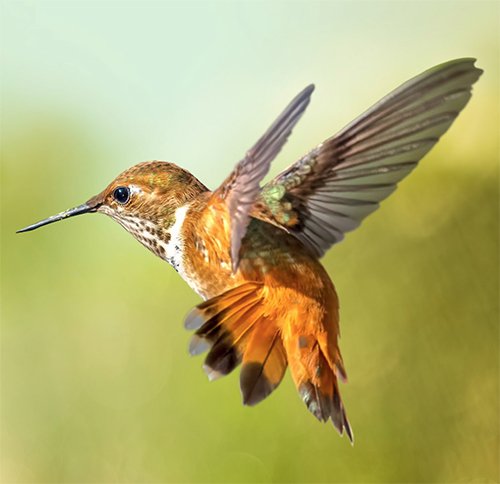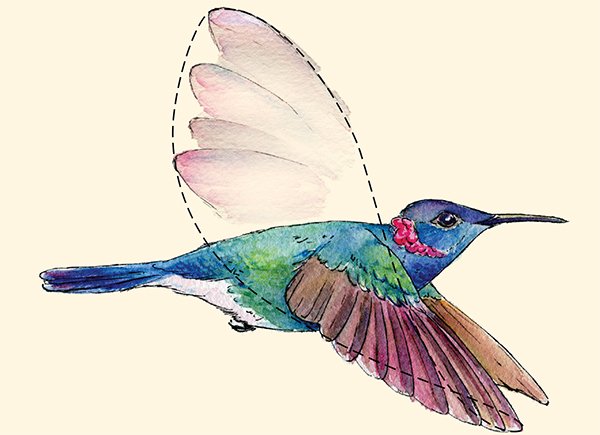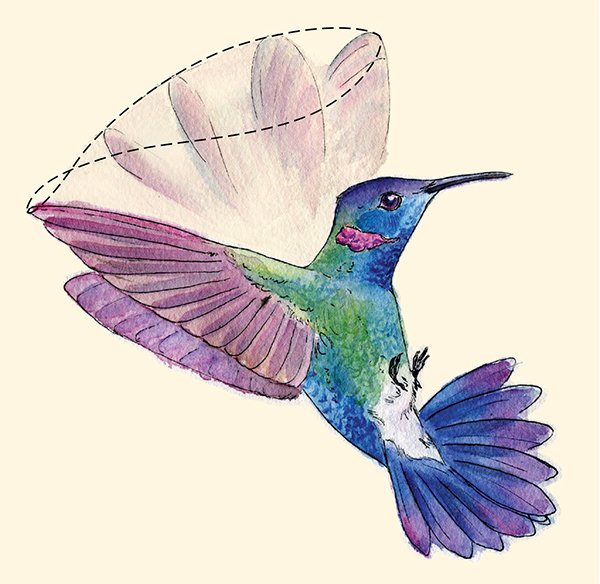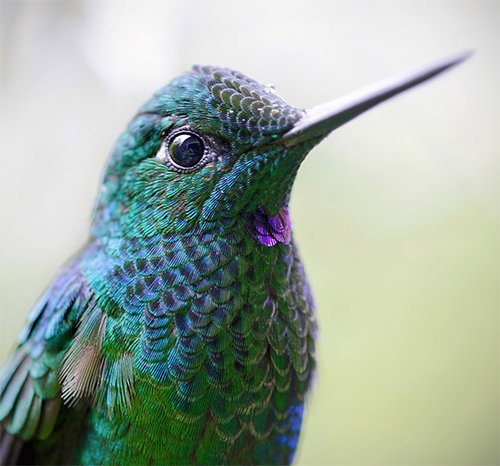Hummingbirds—Avian Acrobats of the Americas
We marvel at birds in flight. But one kind of bird stands apart in its acrobatic talents, with a complex flight system unlike any other.
Picture yourself relaxing in the floral bouquet of a butterfly garden when suddenly the buzz of a gigantic bee tingles your ears, followed by an explosion of brilliant color. Then, as quickly as it disrupts your peaceful world, the UFO vanishes without a trace. After the shock passes, it dawns on you. You’ve just witnessed one of the greatest shows on earth.
No, Barnum and Bailey had nothing to do with it, and this wasn’t a close encounter of an alien kind. You have encountered one of the most amazing and mysterious birds on the planet!
The hummingbird may be one of the most well-known birds on earth, yet this colorful acrobat continues to mystify the greatest mathematicians and aeronautical engineers. Just when they think they’ve learned all there is to learn about these birds, they discover more.
Hummers differ greatly from other birds. While most of their feathered friends fly by thrusting forward like jets, these aerialists can stop on a dime, hover, somersault, fly backward, and even fly upside down. No other creature can match their skills. And man-made craft don’t compare. (What helicopter can cross the Caribbean Sea on a half ounce of fuel?)
Only the skill of an all-knowing Creator and Engineer could explain all the integrated systems necessary to make such flight possible. It’s a package deal, not something that could arise piecemeal by trial and error.
Hovering Ain’t Easy
Bird flight is arguably the pinnacle of God’s design in the animal kingdom. For millennia, humans have marveled at the wonderful traits shared by birds—their aerodynamic bodies, flexible feathers, and ultralight building materials. Yet hummingbirds are special, even among birds. Some say they’re the pinnacle of God’s pinnacle of animal design.
They perform a rare role among birds—pollinating flowers—which requires hovering. Like large insects, they must be able to hover at the end of long flower stems and insert their long bills and tongues to draw out nectar. No other bird lives this way; other birds simply grab food “on the go” or perch to eat.
We admire eagles and swallows for their power and grace, but they can’t hover. Their wings must constantly move through the air or they will stall and crash. Fixed-wing planes can’t hover, either, for the same reason. The only way helicopters can perform this wonder is by a complex combination of designs that channel the engine’s energy to turn a rotor with blades that create their own controlled airflow (like a mobile fan pointing downward).
How do hummingbirds create their own airflow without spinning blades? The answer isn’t simple. In fact, we still don’t understand it all. But one thing is clear, everything about the hummingbird must be perfectly balanced to achieve maximum airflow at minimum cost. Somehow, hummingbirds solve a host of engineering problems that boggle the mind.
High-Octane Featherweights
The challenge begins with size. What’s the optimum size for hovering? Well, you’ve never seen a hummingbird the size of condors or eagles. There’s a good reason for this. You can’t stick twirling blades on top of birds, so you have to go small. And hummingbirds are the king of small.
Hummers are the avian featherweights in the truest sense. They have the smallest length of any bird (Cuba’s bee hummingbird is only 2.5 inches [6 cm] long) and the lowest weight (the average male ruby-throat weighs 0.1 ounces [3 g]).
Their need for lightness extends to their eggs. Female hummingbirds can’t afford to carry around unnecessary weight. So they lay the tiniest eggs of any bird, smaller than a jellybean (0.5 inches [1.2 cm]). And they usually lay only two per clutch.
While minimizing size and weight, hummingbirds also have a voracious appetite for fuel to keep their “fan” blowing. Though small, they still need to travel fast and cover long distances in search of food, to avoid large predators, and to find safe breeding ground.
Rufous hummingbirds hold the world record hummer migration distance. Each year they fly an unbelievable 3,900 miles from their wintering grounds in Mexico to their nesting grounds in Alaska or Canada! On these trips, they travel at an average speed of 30 mph (50 km/hr.) and consume as much as one-half their body weight in fuel per day.

The rufous hummingbird has the longest migration of any hummingbird species. These hummers fly more than 3,000 miles from their nesting grounds in Alaska and Canada to their winter habitat in Mexico.
Seeds are too inefficient to carry around in their stomachs to meet these high-energy needs. This power source would be like fueling a jet with a wood stove.
The secret to their success is a high-octane fuel: the sweet-smelling nectar that tube-shaped flowers produce just for this occasion. The sugar is converted to flight energy with 97% efficiency—a real winner in the avian world. By God’s design, they can find this refined fuel virtually anywhere, like a gas station at every corner, ready 24/7 to supply the hummingbirds’ needs.
And their needs are great. Active hummers must feed on this nectar five to eight times per hour, though they are not opposed to an occasional snack of insects and spiders.
Engines require more than just fuel. They need oxygen. Lots of it. Birds get their oxygen through their lungs, where it is transferred into their bloodstream by rapidly beating hearts. (Bird lungs aren’t like any other creature’s lungs, but that’s a different story.) With hearts aflutter at an astounding 1,200 beats per minute, hummingbirds have the highest inflight energy and oxygen requirements of all birds. Even at rest, they breathe 250 breaths per minute, and this rate increases dramatically when they jet out! This rapid oxygen intake enables them to generate flapping rates of 10 to 200 beats per second, depending on the species and flight circumstances. (Can you see a hawk doing that?)
Crazy Eight Flight
Bird aviation of any kind is complex. It’s so complex, in fact, that mathematicians have not yet worked out the numeric details. Add to the equation hummingbird acrobatics, and the mathematical complexities skyrocket!
Most birds fly with a relatively simple up-and-down motion. Hummers, by contrast, rely on three basic types of wing motion: up-and-down motion to move forward (like other birds), spinning motion overhead to move backward, and a “figure eight” motion to hover (see graphic).
Hummer Helicopter
Hummingbirds have more flight abilities than other birds. Like a helicopter, they can hover, fly sideways and backward, and even do backward somersaults as they dart among flowers searching for nectar and insects. Most bird wings bend in the middle, but hummingbird wings are rigid. A special shoulder joint allows them to pivot their entire wings 180 degrees, giving them options other birds (and helicopters) don’t have.
Forward

Illustration by Katie Compton
Like other birds, hummingbirds fly forward with a constant downstroke. They can maintain impressive speeds of 30 miles per hour.
Backward

Illustration by Katie Compton
Hummingbirds fly backward simply by rotating their wings so that each stroke is over their heads. They can fly just as fast backward as forward, and without expending extra energy.
Hover

Illustration by Katie Compton
The hummingbird’s hovering motion is possible because it can rotate its wings in a figure eight. In this way, both the forward and backward stroke push down.
The ability to hover is the most amazing of all. Other birds produce thrust only on their downstroke. They bend their “wrist” and “elbow” in the middle of the wing to make subtle changes during the downstroke, but they can’t push air during the upstroke. Hummingbirds, in contrast, can pivot their entire wings at the shoulder, producing thrust on the upstroke, too.
How do they do this? A unique ball-and-socket joint in their shoulder lets them rotate their wing instantly in either direction—up to 180 degrees! This allows them to constantly push the leading edge of their wing through the air, even on the upstroke. The crazy-eight motion also moves the wings through more air, increasing their efficiency.
The hummingbirds’ pivoting wings allow them to remain stable while hovering, without bouncing up and down. And this design explains how they can change directions at the drop of a hat. With slight variations in their figure eight, they can also slide sideways and do other acrobatics.
Their flight abilities have been compared with dragonflies rather than other birds. In fact, when Europeans first discovered them in the New World, some thought they were a cross between insects and birds! Hummingbird wings are stiff like an insect’s wings (although they can still bend them in the middle, enabling them to do some tricks insects can’t). Their flapping creates complex vortices in the air, which we are still trying to understand. That’s what allows huge bumblebees to fly with such short wings. Hummingbirds take advantage of these invisible forces to increase their lift, too. They don’t just beat their wings harder; they optimize forces of physics, which we can only now begin to understand with the help of advanced computers.
Everything in the hummingbird is carefully balanced to maximize flight power and minimize weight. Their powerful chest muscles take up 25–30% of their body weight, more than any other bird. In this complex tradeoff, their legs and feet are extremely small; so small, in fact, that they can’t walk. They can only perch and hop sideways on branches. This seeming disability is not a disability at all, but is important in cutting down drag during flight.
Wired for Aviator Acrobatics
Imagine what it takes to control all these interrelated systems at super speeds. Two separate wings constantly rotate and flip, sometimes at different angles and speeds during special maneuvers. The tail and other body parts counterbalance every wing motion to keep the body perfectly stable while hovering. Meanwhile, firing electrical signals regulate the fastest beating heart on the planet. The eyes must constantly process a visual field that changes dramatically in three dimensions. And on it goes.
Intense research, published this year, has looked into the hummingbird brain to see how all this is possible. Specifically, researchers have looked at the region known as the lentiformis mesencephali or LM for short. This is the part of the brain designed to detect the hummingbird’s motion relative to its surroundings.

The green-crowned brilliant resides in the highlands from Costa Rica to western Ecuador. Unlike many other hummingbirds, this gem almost always perches to feed.
Most birds and mammals primarily detect their motion visually in one preferred direction, from back to front (the direction they usually move). But the hummer’s LM is bigger than other birds’, and it can perceive its own motion precisely and equally well in all directions, especially at high speeds.
The research suggests that hummers can even correct for very slight drift when hovering. In fact, the scientists’ overall conclusion is that their brain is designed for flight!
Engineers can only marvel at such
complex systems within systems
within systems that make hummingbird
acrobatics possible (from the programming
of the cell chemistry that
builds and runs cells, to the tissues and
organs and organ systems that “talk” to
each other and coordinate flight). For
believers in Jesus the Christ, this conclusion
is consistent with the scripture
where God said at Creation, “Let birds
fly above the earth across the expanse
of the heavens
” (Genesis 1:20). Such
integrated technologies wondrously
declare the glory of the Creator.
Overcoming Challenges of a Fallen World
When God created birds, suffering and death were not a part of this world. Now every creature, including hummingbirds, must survive the ravages of an environment that’s off kilter. Yet God made sure hummers were ready for the challenge. Their speed and agility make them fearless, even against large predators. They are notoriously aggressive, chasing away hawks and other threats without hesitation because they know they can outmaneuver them!
God has endowed them with other onboard equipment necessary to meet the challenges that the natural world can throw at them. One of the most significant dangers is cold weather at night.
Many hummers live in places where temperatures drop below freezing at night. Many also live at high elevations, such as the Andes Mountains, where limited oxygen puts an added strain on their high-energy system. Without a constant input of fresh fuel, they would burn all their reserves and perish within an hour or two.
But our God has designed them to lower their body temperature and decrease fuel consumption by 95% at night. This is known as a torpor, sort of like a short-term hibernation.
The hummingbird is a visual reminder that God gives life and cares for his creatures, in spite of sin and its effects. His creation is meant to redirect our gaze back on him (Romans 1:20). The hummingbird reminds us of his infinite intelligence, his engineering creativity, his all-surpassing beauty, and most importantly his loving provision.
May the complexity and the mystery of the hummingbird be a reminder to all that God exists, that he wishes to be known, and that he offers eternal life to everyone who calls upon the name of his Son, Jesus Christ.
Jesus himself reminds us, “I tell you, do not be anxious about your life,
what you will eat or what you will drink, . . . Look at the birds of the air: they
neither sow nor reap nor gather into barns, and yet your heavenly Father
feeds them. Are you not of more value than they?
” (Matthew 6:25–26).
Related Videos
Flight: The Genius of Birds Excerpt
Answers Magazine
July–August 2017
Journey with the Answers magazine staff to experience Flood evidences firsthand during a raft trip in the Grand Canyon.
Browse Issue SubscribeRecommended Resources

Answers in Genesis is an apologetics ministry, dedicated to helping Christians defend their faith and proclaim the good news of Jesus Christ.
- Customer Service 800.778.3390
- © 2024 Answers in Genesis






